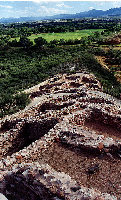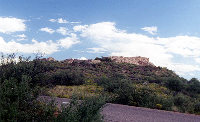Tuzigoot
is a Sinagua ruin that is perched on a 150 ft. hill between
the towns of Jerome and Clarkdale, located close to
the Verde River. The community was occupied for approximately 400
years, and was not all built at
once, but was built piece by piece and phase by phase beginning
just before AD 1000 and ending just prior to AD 1400.
History: The Hopi had a trail which led from their mesas in the north
to the Verde Valley. In 1582, Don Antonio de Espejo set out
on an expedition from Mexico. He was looking for gold and
was led by the Hopi to the Tuzigoot area from Awatovi. A pleasant
land of rivers, trees, grapes, walnuts, and many other plants
greeted him. Not finding what he was looking for, he departed
shortly thereafter.
Due
to looting in the 1920s, an
excavation of Tuzigoot was launched in 1933. In an effort to preserve the ruins, the land was bought from
the United Verde/Phelps Dodge mine for the sum of $1.00 and
turned over to the county, who shortly thereafter gave it to
the federal government. The ruin was made a National Monument in 1939 by
Theodore Roosevelt.
Excavations
have revealed figurines made of split twigs, along with the normal pottery shards, manos and metates, etc.
The
interior walls were coated with a red clay plaster. Tuzigoot is
the only example of this type of ruin. Hatalacva, a ruin on a nearby hill,
has not been excavated. Anciently, there were
a number of similar communities in the Verde Valley. Most were within sight of
each other.
Location: Tuzigoot is located just off Az. 279/Alt 89 midway between
Clarkdale and Cottonwood, Arizona. It is about 2.5 hours
north of Phoenix. |



